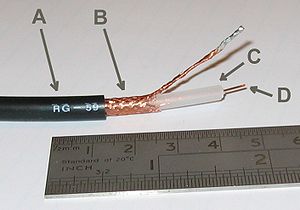
RG-59 coaxial cable A: Plastic outer insulation B: Copper-clad aluminium braid shield conductor C: Dielectric D: Central conductor (copper-clad steel) (Photo credit: Wikipedia)
Copper is still a very relevant technology today, and when looked at on a global scale nearly 2/3 of all broadband subscribers are still served by copper. That percentage is smaller in the US, but this country has a far more widely deployed cable TV system than most of the rest of the world.
The most widely deployed DSL technologies today are ADSL2 and VDSL. In theory these technologies can get speeds up to about 40 Mbps. But depending upon the gauge, the age and the condition of the copper many actual deployments are closer to 20 Mbps than the theoretical 40 Mbps.
ADSL2 and VDSL technology has been widely deployed by AT&T in its U-verse product which serves over 7 million data customers and over 4.5 million cable customers. AT&T has made the product available to over 24 million homes. AT&T can support the product up to about 3,500 feet on good single copper pair and up to 5,500 feet using a two bonded copper pairs.
And ADSL2 is a pretty decent product. It can deliver IPTV and still support an okay data pipe. However, as the cable companies are finding ways to get more bandwidth out of their coaxial cable and as new companies are deploying fiber, these DSL technologies are going to again fall behind the competition.
So what is out there that might resurrect copper and make speeds faster than ADSL2? Not too long ago I wrote a blog about G.Fast, which is Alcatel-Lucent’s attempt to find a way to get more speeds out of legacy copper networks. In recent field tests ALU achieved a maximum speed of 1.1 Gbps over 70 meters and 800 Mbps over 100 meters for brand new copper. On older copper the speed dropped to 500 Mbps for 100 meters.
However, the G.Fast distance limitations are far shorter than ADSL2 and G.Fast is really more of a drop technology than a last mile technology and it would require a telco like AT&T to build a lot more fiber to get even closer to houses. You have to wonder of it makes any sense to rebuild the copper network to be able to get up to 500 Mbps out of copper when fiber could deliver many gigabits.
There are other technologies that have been announced for copper. Late last year Genesis Technical Systems announced a scheme to get 400 Mbps out of copper using a technology they are calling DSL Rings. This technology would somehow tie 2 to 15 homes into a ring and bridge them with copper. Details of how the technology works are still a little sketchy.
In 2011 the Chinese vendor Huawei announced a new technology that will push up to 1 gigabit for 100 meters. This sounds very similar to G.Fast and sounds like a way to use existing copper within a home rather than rewiring.
There is one new technology that is finally getting wider use which is bonded VDSL pairs that use vectoring. Vectoring is a noise cancellation technology that works in a way similar to how noise-cancelling headphones work to eliminate sound interference. Vectoring eliminates most of the noise between bonded pairs of copper. Alcatel-Lucent hit the market with bonded pair VDSL2 in late 2011 that can deliver up to 100 Mbps. However, in real deployment speeds are reported to be 50 Mbps to 60 Mbps on older copper. That is enough speed to probably give another decade to DSL, although to do so requires a full replacement of old technology DSL technology with VDSL2. One has to wonder how many times the telcos will keep upgrading their copper electronics to get a little more speed rather than taking the leap to fiber like Verizon did.
One only has to take a look at the growth rate of the data used at homes and ask how long copper can remain relevant. Within a few short decades we have moved from where homes could get by on dial-up and now find a 20 Mbps connection too slow. Looking just a few years forward we see the continued growth of video sharing and a lot of new traffic from cellular femtocells and the Internet of Things. It’s hard to think that it won’t be long until people are bemoaning the inadequacy of their 50 Mbps connections. But that day is coming and probably is not more than a decade away.

Pingback: Is There any Life Left in Copper? | Libatech